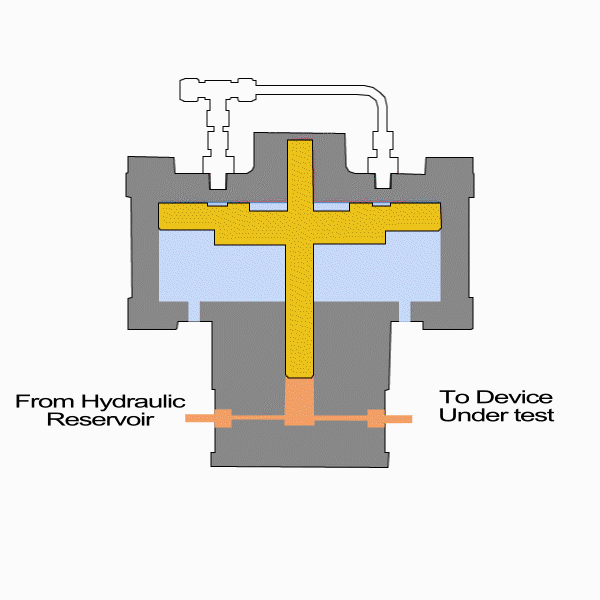There are a number of ways to generate pressure for a hydraulic calibration. One of the most common ways is to use an automated, hybrid system utilizing a pneumatic pressure source and a hydraulic pressure measurement controller. Using some basic principles of physics, a relatively low pressure pneumatic source can generate up to 100 times greater hydraulic pressures. Throughout this article, we’ll discuss the general design, the benefits, and some of the limitations of this type of calibration.
If you’ve ever taken an entry level physics class, one of the first lessons you learn is that a person wearing high heels exerts more pressure on the ground than an elephant! Believe it or not, this relationship is the same idea that drives a pneumatic to hydraulic pressure controller. The rule states that pressure is equal to the force over a given surface area, simply P = F/A. In a closed system, Pascal’s Principle comes into play: P1=P2, or F1/A1 equals F2/A2. The figure shown below, with the yellow plate as A1 and the bottom of the yellow piston as A2, demonstrates how this force is transferred.

For example, if A1 is 10 times larger than A2, the pressure on the bottom will be 10 times greater. Now imagine if that disc area is 50 or even 100 times larger in diameter, which is exactly how a Mensor CPC8000-H Hydraulic Pressure Controller is able to generate pressures greater than 20,000 psi.
If you assume the common idea that oil or water is non-compressible it must mean you haven’t read our compressibility blogs, because all hydraulic media is compressible.
If you study the graphic above, you’ll notice how the piston moves up and down to transfer the force to the hydraulic medium. This movement is called the stroke of the piston. In any hydraulic system using this type of mechanism, there is inevitably a maximum stroke that is achievable. The full stroke of the piston will be realized when the system is compressed to the “bottom” of the piston shaft. The maximum stroke is physically constant, but the pressure at which that maximum is reached is all dependent on the medium and the purging process. If the wrong medium is chosen or the measure/control port of a controller contains a lot of highly compressible, air molecules, the controller may only reach 75% or even 50% of the specified control range. Following the manufacturer’s suggested purging processes, media requirements, and volume limitations will ensure the optimal performance of your hydraulic controller.
With some hydraulic control systems controlling high-pressue, pressurized systems can create an increasingly dangerous environment. If you’ve ever been around leaks in a pneumatic and a hydraulic system, you know there is a significant difference. A pneumatic leak, even at low pressures, can be quite violent with hoses whipping around or projectiles potentially flying out causing severe damage to personnel as well as equipment. This is primarily because of the high compressibility of air molecules. On the other hand, a hydraulic burst in a system is much less spectacular, as it generally results in a small amount of fluid being sprayed or dripping from the leak point. While much messier and annoying to clean up, it is typically much safer than a pneumatic breach. In order to create a safe environment around a hydraulic controller for workers as well as other equipment, pneumatic pressure is always used as the lower, drive pressure.
The graphic above demonstrates how controllers like the CPC8000-H function. Notice how the pneumatic supply pressure (shown filling with blue in the graphic) begins to fill the chamber as the system pressurizes. While still dangerous, these pneumatic pressures rarely exceed a few hundred psi.
Not only is this design done for safety, but it is also a stable way to work with hydraulic systems. Pressure control, especially in calibration labs, requires a very stable output. In controllers like the CPC8000-H, a finely tuned pneumatic controller is connected to the top portion of the intensifier. Using proper seal material, lubrication grease or oil, and precisely machined intensifier components, like the piston, the intensifier system allows for a free moving piston that transfers the pneumatic pressure to the hydraulic medium. This provides the system with a high level of stability at the output of the controller.
With a mixture of physics, safety and control innovation; hybrid calibration systems featuring pneumatic and hydraulic pressure calibrating controllers have become a staple for labs when pressure over 10,000 psi is required in precision pressure calibration.


